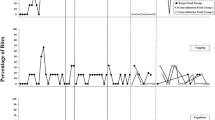Abstract
Pediatric feeding disorders are common among children with developmental disabilities and can have detrimental effects on growth and development. An escape extinction and negative reinforcement-based approach to treating food refusal was examined in a child with cerebral palsy. A changing criterion treatment design was implemented, which allowed the child to exit the treatment area contingent upon the acceptance and ingestion of a pre-determined number of bites. Food acceptance ranged from one to three bites at baseline and exceeded the pre-set criteria for mastery, at 14 bites during the final intervention phase.
-
The study will contribute to the current literature on negative reinforcement procedures used in the treatment of pediatric feeding problems.
-
The study will contribute to increasing the availability of literature pertaining to pediatric feeding problems among children with complex disabilities such as cerebral palsy.
-
The intervention is brief with components to the treatment package which increases utility and ease of implementation.
-
The study demonstrates the applicability of changing criterion design within clinical settings.

Similar content being viewed by others
References
Dawson, J. E., Piazza, C. C., Sevin, B. M., Gulotta, C. S., Lerman, D., & Kelley, M. L. (2003). Use of the high-probability instructional sequence and escape extinction in a child with food refusal. Journal of Applied Behavior Analysis, 36, 105–108.
Piazza, C., Patel, M., Gulotta, C., Sevin, B., & Layer, S. (2004). On the relative contributions of non-contingent reinforcement and escape extinction in the treatment of food refusal. Journal of Applied Behavior Analysis, 37, 27–42.
Piazza, C., Roane, H. S., & Kadey, H. J. (2009). Treatment of pediatric feeding disorders. Treating Childhood Psychopathology and Developmental Disabilities, 435–444.
Sharp, W. G., Jacques, D. L., Morton, J. F., & Herzinger, C. V. (2010). Pediatric feeding disorders: a qualitative synthesis of treatment outcomes. Clinical Child and Family Psychology Review, 13, 348–365.
Vaz, P., Volkert, V., & Piazza, C. (2011). Using negative reinforcement to increase self-feeding in a child with feed selectivity. The Journal of Applied Behavior Analysis, 44, 915–920.
Williams, K. E., Field, D. G., & Seiverling, L. (2010). Food refusal in children: a review of the literature. Research in Developmental Disabilities, 625–633.
Ethical Statement
This manuscript has not been submitted to any other journals for simultaneous consideration. The manuscript has not been published previously (partly or in full). A single study is not split up into several parts to increase the quantity of submissions and submitted to various journals or to one journal over time (e.g., “salami-publishing”). No data have been fabricated or manipulated (including images) in order to support the conclusions. No data, text, or theories by others are presented as if they were the author’s own (“plagiarism”). Proper acknowledgements to other works must be given (this includes material that is closely copied (near verbatim), summarized and/or paraphrased), quotation marks are used for verbatim copying of material, and permissions are secured for material that is copyrighted. Consent to submit has been received explicitly from all co-authors, as well as from the responsible authorities—tacitly or explicitly—at the institute/organization where the work has been carried out, before the work is submitted. Authors whose names appear on the submission have contributed sufficiently to the scientific work and therefore share collective responsibility and accountability for the results.
Author information
Authors and Affiliations
Corresponding author
Rights and permissions
About this article
Cite this article
Voulgarakis, H., Forte, S. Escape Extinction and Negative Reinforcement in the Treatment of Pediatric Feeding Disorders: a Single Case Analysis. Behav Analysis Practice 8, 212–214 (2015). https://doi.org/10.1007/s40617-015-0086-8
Published:
Issue Date:
DOI: https://doi.org/10.1007/s40617-015-0086-8




